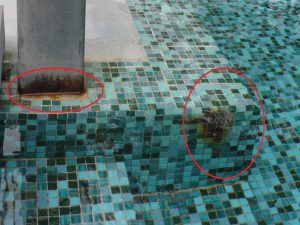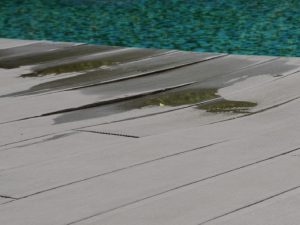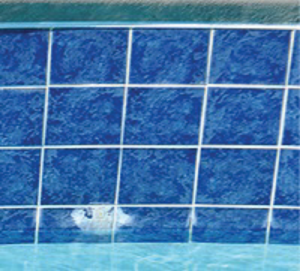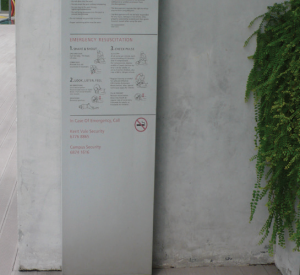Building Materials Issues

Corrosion of column and tiles along pool stairs

Defective and warped wooden flooring by the pool causes water ponding and slipping

Stains on pool tiles

Safety signage and behaviour rules are located away from the entrance, and cannot be directly seen by all users
Design Guidelines
- Ladders must be made of corrosion-resistant materials and have slip resistant tread surfaces with maximum distance (300mm) between ladder rungs. Provide two handholds or handrails to all rungs (max. dia. of handrail 50mm and min. dia. of handrail 30mm) (SS 556:2010). (See also AS 2610.1-2007 and AS 2610.2-2007).
- Consider water presence, pool, and cleaning chemicals when specifying building materials (e.g. concrete, tiles, adhesives, grouts) (BS EN 1992-3:2006). (See also AS 2610.1- 2007 and AS 2610.2- 2007).
- Floor gullies, gutters and valleys should not constitute a tripping hazard; refer to the detailed design issues related to these features as per Time Saver Standards [1].
Construction Guidelines
- The construction should bear full and empty conditions of the pool. The pool/pool features should be constructed with inert, stable, nontoxic materials which are durable and watertight. Working stresses are to be based on predetermined ultimate strengths of materials used, with a factor of safety of not less than 2t/z [1]. (See also BS EN 1992-1:2006, BS EN 1992-3:2006, BS EN 15288-1:2008, AS 3600-2009 and AS 3735-2001).
- Appropriate surface finishes should be used. They are to enhance the safety and hygiene of the premises, and to assist in effective maintenance by enabling dirt and visible contaminants to be easily detected [2].
- Walls and floors should be smooth, impervious, durable, easily cleaned and continuous, with no cracks, joints or protrusions other than structural joints (SS 556:2010). (See also AS 2610.1-2007 and AS 2610.2-2007).
Maintenance Guidelines
- Materials used for landscaping of the pool edge should have a smooth surface, to facilitate easy cleaning (SS 556:2010). (See also AS 2610.1-2007 and AS 2610.2-2007).
- Ensure the clear display of safety signage and behaviour rules [2]. (See also ISO 20712-1:2008 and AS/NZS 2416.3:2010).
- Ensure that the concourse directly surrounding aquatic facilities does not accommodate considerable amounts of water (to avoid pooling and microbial growth), nor have any irregularities (to avoid slip-and-trip hazards) (SS 556:2010). (See also AS 2610.1-2007, AS 2610.2-2007 and BS EN 15288-2:2008).
- Where divers are used for installing, maintaining, repairing or cleaning of swimming pools, the requirements of the Diving at Work Regulations should be followed [2].
References
[1] De Chiara, J. and Crosbie, M.J. (2001). Time Saver Standards for Building Types (4th ed.). USA: McGraw-Hill..
[2] Health and Safety Executive (2003). HSG179: Managing health and safety in swimming pools (3rd ed.). England: HSE Books and Sport England Publications.
Normative References/Standards Referred to for Swimming Pool
• AS 2610.1-2007 — Spa pools — Public spas
• AS 2610.2-2007 — Spa pools — Private spas
• AS 3600-2009 — Concrete structures.
• AS 3735-2001 — Concrete structures for retaining liquids
• AS/NZS 2416.3:2010 — Water safety signs and beach safety flags — Guidance for use
• BS EN 15288-2:2008 — Swimming pools. Safety requirements for operation
• BS EN 1992-1:2006 — Design of concrete structures. General rules and rules for buildings
• BS EN 1992-3:2006 — Design of concrete structures — Part 3: Liquid retaining and containment structures
• ISO 20712-1:2008 — Water safety signs and beach safety flags — Part 1: Specifications for water safety signs used in workplaces and public areas
• SS 556:2010 — Code of practice for the design and management of aquatic facilities